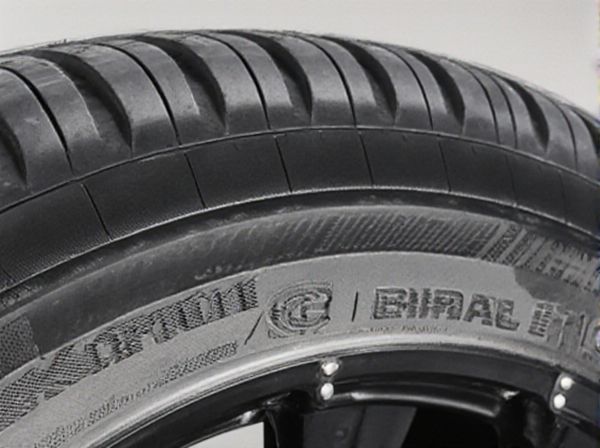
Photo illustration: Radial vs Bias Ply
Radial tires feature layers of fabric with cords running perpendicular to the direction of travel, offering improved flexibility, better traction, and longer tread life compared to bias ply tires. Bias ply tires have overlapping layers with cords running diagonally, providing a stiffer sidewall and better resistance to rough terrain, which can be beneficial for heavy-duty applications. Choosing the right tire type affects your vehicle's handling, ride comfort, and durability depending on your specific driving conditions.
Table of Comparison
| Feature | Radial Tire | Bias Ply Tire |
|---|---|---|
| Construction | Steel belts run radially from bead to bead | Layers of fabric cords at diagonal angles |
| Flexibility | More flexible sidewalls | Stiffer sidewalls |
| Ride Comfort | Smoother and quieter ride | Rougher ride with more noise |
| Durability | Longer tread life, better heat dissipation | Stronger sidewall resistance to cuts |
| Traction | Better wet and dry traction | Good off-road traction |
| Fuel Efficiency | Improved fuel economy | Lower fuel efficiency |
| Cost | Usually more expensive | Generally less expensive |
| Common Use | Passenger cars, light trucks | Trailers, vintage cars, off-road vehicles |
Introduction to Tire Construction
Radial tires feature steel belts arranged perpendicular to the tread, providing improved flexibility, better traction, and enhanced fuel efficiency compared to bias ply tires. Bias ply tires have multiple layers of fabric plies placed diagonally, creating a stiffer sidewall that offers durability and load-carrying capacity, often preferred in heavy-duty or off-road applications. Understanding the differences in ply orientation and materials is essential for selecting the appropriate tire construction based on performance, ride comfort, and vehicle type.
What is Radial Ply Tire Design?
Radial ply tire design features cords that run perpendicular to the direction of travel, extending from bead to bead, which enhances flexibility and traction. The steel belts beneath the tread provide strength and durability, improving fuel efficiency and tread life compared to bias ply tires. This design reduces rolling resistance and offers better heat dissipation, making radial tires ideal for modern vehicles and high-speed applications.
What is Bias Ply Tire Design?
Bias ply tire design features layers of fabric cords arranged diagonally from one bead to the other, typically at angles between 30 and 40 degrees to the tire's centerline. This construction creates a tough, flexible sidewall ideal for off-road and vintage vehicle use due to enhanced resistance to punctures and cuts. While bias ply tires provide a smoother ride on rough surfaces, they generally offer less traction and fuel efficiency compared to radial tires.
Key Structural Differences
Radial tires feature cord plies arranged at 90 degrees to the direction of travel, providing enhanced flexibility and improved ground contact, while bias ply tires have cords laid at alternating angles of 30 to 45 degrees, resulting in a stiffer sidewall construction. The radial design enables better heat dissipation and tread wear, offering superior fuel efficiency and ride comfort. Conversely, bias ply tires deliver greater resistance to sidewall punctures and are often favored for heavy-duty or off-road applications due to their rugged structure.
Performance Comparison: Radial vs Bias Ply
Radial tires offer superior handling, fuel efficiency, and tread life due to their flexible sidewalls and steel belt construction, enhancing grip and heat dissipation at higher speeds. Bias ply tires feature stiffer sidewalls with crisscrossed fabric plies, providing increased load capacity and durability on rough terrain but sacrificing ride comfort and traction compared to radials. Performance comparison clearly favors radial tires for highway driving and everyday use, while bias ply tires excel in off-road and heavy-duty applications.
Durability and Longevity
Radial tires offer superior durability and longevity due to their flexible sidewalls and steel-belted construction, which evenly distributes stress and reduces heat buildup during use. Bias ply tires, with their crisscrossed layers, tend to wear out faster because of increased heat generation and less effective stress distribution. Consequently, radial tires typically provide longer tire life and better resistance to road hazards compared to bias ply tires.
Ride Comfort and Handling
Radial tires offer superior ride comfort due to their flexible sidewalls and steel belt construction, which absorb road shocks more effectively than bias ply tires. Bias ply tires, with their crisscrossed fabric plies, provide stiffer sidewalls that enhance handling precision and durability but often result in a harsher ride. For smoother driving experiences, radial tires excel in reducing vibrations, while bias ply tires are preferred in off-road or heavy-duty applications where handling under load is critical.
Applications and Suitability
Radial tires provide enhanced fuel efficiency, improved tread life, and superior handling, making them ideal for passenger vehicles, highway driving, and long-distance travel. Bias ply tires feature stronger sidewalls and increased durability, often preferred for off-road vehicles, agricultural machinery, and heavy-duty trucks where rugged terrain and heavy loads are common. The suitability of radial versus bias ply tires depends on the specific application requirements, such as load capacity, terrain type, and driving conditions.
Cost Considerations
Bias ply tires generally have a lower initial purchase price compared to radial tires due to simpler manufacturing processes and materials. Radial tires offer longer tread life and improved fuel efficiency, which can offset their higher upfront cost through reduced maintenance and operating expenses over time. Fleet operators often weigh the upfront cost savings of bias ply against the long-term economic benefits provided by radial tires when making procurement decisions.
Choosing the Right Tire for Your Needs
Selecting the right tire involves understanding the differences between radial and bias ply tires, where radial tires offer improved fuel efficiency, better traction, and longer tread life due to their flexible sidewalls and steel belts. Bias ply tires provide enhanced durability and handling on rough terrains because of their layered crisscross construction, making them ideal for heavy loads and off-road conditions. Evaluating your driving habits, vehicle type, and typical road conditions ensures you choose a tire that maximizes performance, safety, and cost-effectiveness.
 caratoz.com
caratoz.com